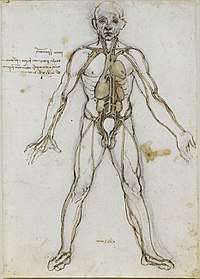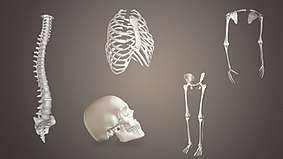List of bones of the human skeleton
The human skeleton of an adult consists of around 206 to 208 bones, depending on the counting of the sternum (which may alternatively be included as the manubrium, body of sternum, and the xiphoid process)[1] It is composed of 270 bones at birth, but later decreases to 80 bones in the axial skeleton and 126 bones in the appendicular skeleton. Many small accessory bones, such as some sesamoid bones, are not included in this count.
 |
| Part of a series of lists about |
| Human anatomy |
|---|
|
General |
Introduction
As a human ages, some of its bones fuse, a process which typically lasts until sometime within the third decade of life. Therefore, the number of bones in an individual may be evaluated differently throughout their life. In addition, the bones of the skull and face are counted as separate bones, despite being fused naturally. Some reliable sesamoid bones such as the pisiform are counted, while others, such as the hallux sesamoids, are not.
Individuals may have more or fewer bones than the average (even accounting for developmental stage) owing to anatomical variations. The most common variations include sutural (wormian) bones, which are located along the sutural lines on the back of the skull, and sesamoid bones which develop within some tendons, mainly in the hands and feet. Some individuals may also have additional (i.e., supernumerary) cervical ribs or lumbar vertebrae.
Bones
The axial skeleton, comprising the spine, chest and head, contains 80 bones. The appendicular skeleton, comprising the arms and legs, including the shoulder and pelvic girdles, contains 126 bones, bringing the total for the entire skeleton to 206 bones.
Spine (vertebral column)
A fully grown adult features 26 bones in the spine, whereas a child can have 33.
- Cervical vertebrae (7 bones)
- Thoracic vertebrae (12 bones)
- Lumbar vertebrae (5 bones)
- Sacral vertebrae (5 bones at birth, fused into one after adolescence)
- Coccygeal vertebrae (set of 4 bones at birth; some or all fuse together, but there seems to be a disagreement between researchers as to what the most common number should be. Some say the most common is 1, others say 2 or 3, with 4 being the least likely. It is counted as 1 in this article.)
Chest (thorax)

There are usually 26 bones in the chest but sometimes there can be additional cervical ribs in humans. Cervical ribs occur naturally in other animals such as reptiles.
- Hyoid bone (1)
- Sternum (1)
- Ribs (24, in 12 pairs)
- Cervical ribs are extra ribs that occur in some humans.
Head
There are 22 bones in the skull. Including the bones of the middle ear, the head contains 28 bones.
- Cranial bones (8)
- Occipital bone
- Parietal bones (2)
- Frontal bone
- Temporal bones (2)
- Sphenoid bone (sometimes counted as facial)
- Ethmoid bone (sometimes counted as facial)
- Facial bones (14)
- Nasal bones (2)
- Maxillae (upper jaw) (2)
- Lacrimal bone (2)
- Zygomatic bone (2)
- Palatine bone (2)
- Inferior nasal concha (2)
- Vomer (1)
- Mandible (1)
- Middle ears (6 bones in total, 3 on each side)
Arm
There are a total of 64 bones in the arm.
- Upper arm bones (6 bones in total; 3 on each side)
- Humerus (2)
- Pectoral girdle (shoulder)
- Lower arm bones (4 bones in total, 2 on each side)
- Hand (54 bones in total; 27 in each hand)
- Carpals
- Scaphoid bone (2)
- Lunate bone (2)
- Triquetral bone (2)
- Pisiform bone (2)
- Trapezium (2)
- Trapezoid bone (2)
- Capitate bone (2)
- Hamate bone (2)
- Metacarpals (10 bones in total; 5 on each side)
- Phalanges of the hand
- Proximal phalanges (10 bones in total; 5 on each side)
- Intermediate phalanges (8 bones in total; 4 on each side)
- Distal phalanges (10 bones in total; 5 on each side)
- Carpals
Pelvis (pelvic girdle)
The pelvis (or hip bone) is made up of three regions that have fused to form two coxal bones. They are: ilium, ischium, and pubis
Leg
There are a total of 60 bones in the legs.
- Femur (2 bones)
- Patella or kneecap (2 bones)
- Tibia (2 bones)
- Fibula (2 bones)
- Foot (52 bones in total, 26 per foot)
- Tarsus
- Calcaneus or heel bone (2 bones)
- Talus (2 bones)
- Navicular bone (2 bones)
- Medial cuneiform bone (2 bones)
- Intermediate cuneiform bone (2 bones)
- Lateral cuneiform bone (2 bones)
- Cuboid bone (2 bones)
- Metatarsals (10 bones)
- Phalanges of the foot
- Proximal phalanges (10 bones)
- Intermediate phalanges ( 8 bones)
- Distal phalanges ( 10 bones)
- Tarsus